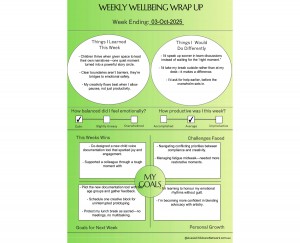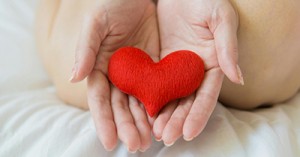Educator wellbeing is crucial for fostering positive interactions and relationships with children, young people, families, and colleagues. It directly impacts the quality of care and education provided, highlighting the importance of supporting educators’ mental and emotional health. The following article provides information on Three Components For Educator Wellbeing, Outcomes Of Positive Practice In The Workplace, Creating A Supportive Environment and Practical Activities To Improve Educator Wellbeing.
Professor Andrea Reupert from Monash University defines educator wellbeing as enjoying life, coping with stress and sadness, working productively, achieving goals, and feeling connected with others. She emphasizes that educators need a supportive, safe, and intellectually stimulating environment to thrive. The World Health Organization defines mental health as the ability to cope with life’s stresses, realize abilities, work well, and contribute to the community. Both individual factors and systemic supports are crucial for educator wellbeing, even in demanding situations.
Three Components Crucial For Educator Wellbeing
- Collegial Relationships: Positive interactions and supportive relationships among staff are essential. Poor relationships, such as bullying or gossip, can harm wellbeing.
- Workplace Culture: A culture of inclusion and belonging is vital. This includes acknowledging diverse identities and creating a comfortable environment for all.
- Leadership: Leaders play a pivotal role in fostering a culture of care, autonomy, and trust. Prioritizing staff wellbeing can significantly impact the overall workplace environment.
Outcomes Of Positive Practice In The Workplace
Working Together In The Workplace
These outcomes are what positive practice looks like for ‘working together’ in a workplace.
Collegial Relationships
- Respectful Communication: Welcoming individual views and ideas.
- Team Planning: Opportunities for respectful team planning and collaboration.
- Open Communication: Active listening and open communication are standard1.
- Supportive Environment: Educators care for and rely on each other.
- Inclusive Spaces: Staffrooms and other environments promote healthy relationships and a sense of belonging.
- Addressing Issues: Timely procedures to handle discrimination and unhealthy communication2.
- Conflict Resolution: Skills for resolving conflicts.
- Recognition: Celebrating individual and team achievements.
- Boundaries: Respecting personal and professional boundaries.
Workplace Culture
- Input and Feedback: Staff can provide input and collaborate on decisions.
- Role Models: Leaders model respectful behavior.
- Help-Seeking: Encouraging a culture where seeking help is normal.
- Collaborative Decision-Making: Building trust within teams.
- Valuing Contributions: Recognizing and valuing staff contributions.
- Engagement: Leaders are visible and engaged in teaching and learning.
- Physical Environment: Enhancing spaces to promote wellbeing and connectedness.
Leadership
- Understanding Roles: Leaders understand their responsibilities.
- Trust and Respect: Strategies to build trust, respect, and value diversity.
- Visible Leadership: Leaders are actively engaged and visible.
- Supportive Environment: Encouraging a help-seeking culture.
- Professional Development: Opportunities for professional growth in wellbeing.
- Physical Spaces: Considering enhancements to physical environments to support wellbeing.
Inclusivity In The Workplace
These outcomes are what positive practice looks like for ‘inclusivity’ in a workplace.
Collegial Relationships
- Respect for Aboriginal and Torres Strait Islander Peoples: Emphasizes the importance of acknowledging and embedding their knowledge and culture within learning communities.
- Inclusive Communication: Encourages respectful and inclusive communication skills and actions.
Workplace Culture
- Responsibility for Learning Protocols: Non-Indigenous educators and those from diverse backgrounds should take responsibility for learning and embedding appropriate cultural protocols.
- Behavior Policies: Establishes and regularly reviews policies to combat racism and bullying, ensuring a respectful workplace culture.
Leadership
- Responding to Stigma and Exclusion: Implements structures and policies to address stigma and exclusion of marginalized educator groups, including LGBTQIA+, culturally and linguistically diverse, Aboriginal and Torres Strait Islander, and people with disabilities.
- Advocacy and Allyship: Leaders should advocate for and support marginalized groups within the educational setting.
Prioritizing Wellbeing In The Workplace
These outcomes are what positive practice looks like for ‘prioritizing wellbeing’ in a workplace.
Collegial Relationships
- Normalizing Wellbeing Conversations: Encourage open discussions about wellbeing.
- Safety and Support: Ensure a safe and supportive work environment.
- Supervision and Mentoring: Provide structures for supervision and mentoring.
- Mental Health Literacy: Promote mental health literacy among staff, children, and young people.
Workplace Culture
- Wellbeing Policies: Implement, share, and regularly review wellbeing policies.
- Optional Wellbeing Initiatives: Offer individual-focused wellbeing activities (e.g., mindfulness) without making them mandatory.
- Regular Evaluation: Monitor and evaluate wellbeing initiatives using local data.
- Accountability: Ensure educator wellbeing is a success indicator with accountability measures.
Leadership
- Recognizing Leaders’ Wellbeing: Normalize and prioritize discussions about leaders’ wellbeing.
- Help-Seeking: Promote a culture where seeking help is encouraged.
- Professional Development: Allocate time for professional development focused on educator wellbeing.
- Data-Driven Initiatives: Collect insights from the learning community to inform wellbeing initiatives.
- Risk Management: Assess and manage psychosocial hazards and risks.
These points highlight the importance of a holistic approach to educator wellbeing, involving supportive relationships, a positive workplace culture, and proactive leadership.
Creating A Supportive Environment
Creating a supportive environment in your school is crucial for the wellbeing of both educators and students. Here are some key strategies based on the guide you’re viewing:
- Positive Culture: Foster a positive organizational culture where educators feel supported, engaged, and valued. This includes promoting respectful relationships and open communication.
- Inclusive Practices: Ensure that all wellbeing initiatives are accessible and inclusive, acknowledging the diverse cultures, experiences, and needs of your staff.
- Leadership Support: Leaders should actively engage in promoting staff wellbeing, modeling respectful behavior, and creating opportunities for staff to provide input and feedback.
- Practical Wellbeing Initiatives: Implement practical and adaptable wellbeing initiatives that are relevant to the daily work of educators, such as providing supervision structures and mentoring.
Practical Activities To Improve Educator Wellbeing
- Mindfulness and Relaxation: Offer activities like yoga, pilates, relaxation sessions, and massages to help staff unwind and stay active.
- Community Events: Organize events such as school BBQs, themed days, and invite staff, students, and parents to foster a sense of community.
- Supportive Environment: Create a welcoming staff room, have an open-door policy, and introduce a mentor system to provide support and encourage open communication.
- Flexible Working: Where possible, offer flexible working arrangements to help educators balance their professional and personal lives
Further Reading
Mindfulness In Early Childhood Setting
A to Z Of Mindfulness Posters
Mindfulness Activity Cards
Quotes For Educators Posters
Deep Breathing Posters
Reference:
BE YOU, Guide For Educators







 As an Educator in Australia, your pay rate falls under the Children’s Services Award 2010. This award states the minimum amount that an employer can
As an Educator in Australia, your pay rate falls under the Children’s Services Award 2010. This award states the minimum amount that an employer can When working as a qualified Early Childhood Teacher (with a university degree) within a service, your rate of pay will come from the Educational Services
When working as a qualified Early Childhood Teacher (with a university degree) within a service, your rate of pay will come from the Educational Services When working as a Diploma Qualified Educator your pay rate is from the Children's Services Award 2010. This Award states your minimum rate of pay
When working as a Diploma Qualified Educator your pay rate is from the Children's Services Award 2010. This Award states your minimum rate of pay When working as a Cert 3 Qualified Educator, your pay rate is from the Children's Services Award 2010. This Award states your minimum rate of
When working as a Cert 3 Qualified Educator, your pay rate is from the Children's Services Award 2010. This Award states your minimum rate of Educational Leaders play a crucial role in their early childhood service by ensuring that the educational program aligns with best practices and supports the holistic
Educational Leaders play a crucial role in their early childhood service by ensuring that the educational program aligns with best practices and supports the holistic In early childhood education and care, ratios are more than a technicality—they are a frontline safeguard. Every child deserves responsive supervision, emotional connection, and developmental
In early childhood education and care, ratios are more than a technicality—they are a frontline safeguard. Every child deserves responsive supervision, emotional connection, and developmental Here’s a comprehensive Mobile Phone and Smart Watch Policy tailored for early childhood education and care (ECEC) services in Australia, aligned with the latest 2025
Here’s a comprehensive Mobile Phone and Smart Watch Policy tailored for early childhood education and care (ECEC) services in Australia, aligned with the latest 2025 With the new national child safety reforms kicking in on 1 September 2025, early childhood services like yours have a real opportunity to lead the
With the new national child safety reforms kicking in on 1 September 2025, early childhood services like yours have a real opportunity to lead the The Sea of Fish Challenge is a national initiative that invites children, educators, families, and communities to create and display fish artworks as a symbol
The Sea of Fish Challenge is a national initiative that invites children, educators, families, and communities to create and display fish artworks as a symbol Across the early childhood education and care sector, educators are sounding the alarm: current staffing ratios are insufficient to deliver safe, meaningful, and developmentally appropriate
Across the early childhood education and care sector, educators are sounding the alarm: current staffing ratios are insufficient to deliver safe, meaningful, and developmentally appropriate


